Accounting and Finance: Company Performance Analysis Report
VerifiedAdded on 2022/12/29
|13
|3327
|62
Report
AI Summary
This report provides a detailed financial analysis of three companies: Greencore Food Plc, Hilton Food Group, and Premium Food Plc. The analysis includes an examination of their goals and objectives, followed by a comparative performance assessment using key financial ratios such as return on equity, profit margin, and current ratio. The report interprets these ratios to evaluate each company's financial health and efficiency over multiple years. Furthermore, the report identifies the best-performing company based on the analysis and justifies the reasons for its superior performance. The second section explores internal and external long-term financing options available to listed companies, discussing the advantages and disadvantages of each source. The report concludes by recommending the most preferred source of funding for these companies based on the overall analysis. The report provides valuable insights into financial performance and financing strategies for businesses.
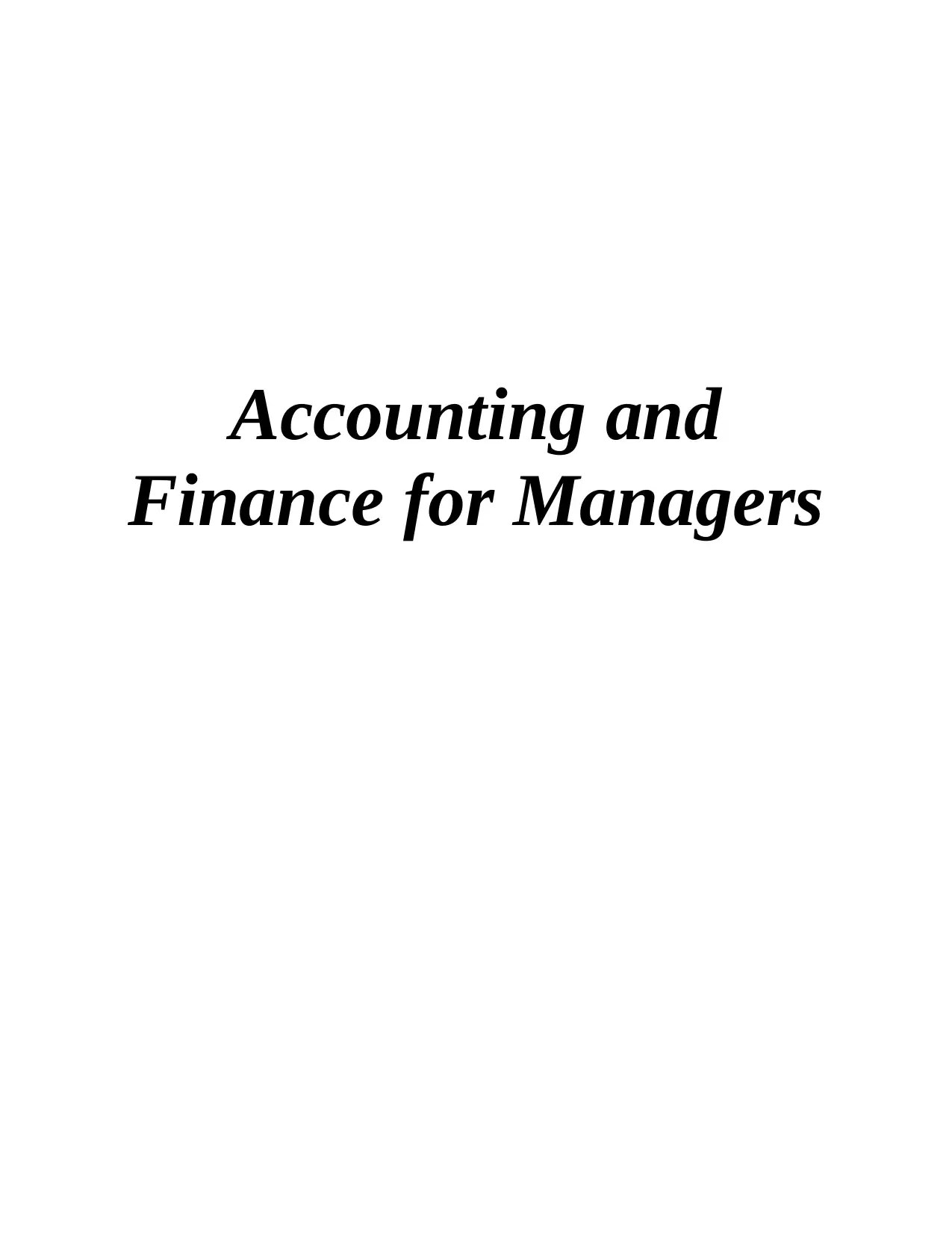
Accounting and
Finance for Managers
Finance for Managers
Paraphrase This Document
Need a fresh take? Get an instant paraphrase of this document with our AI Paraphraser
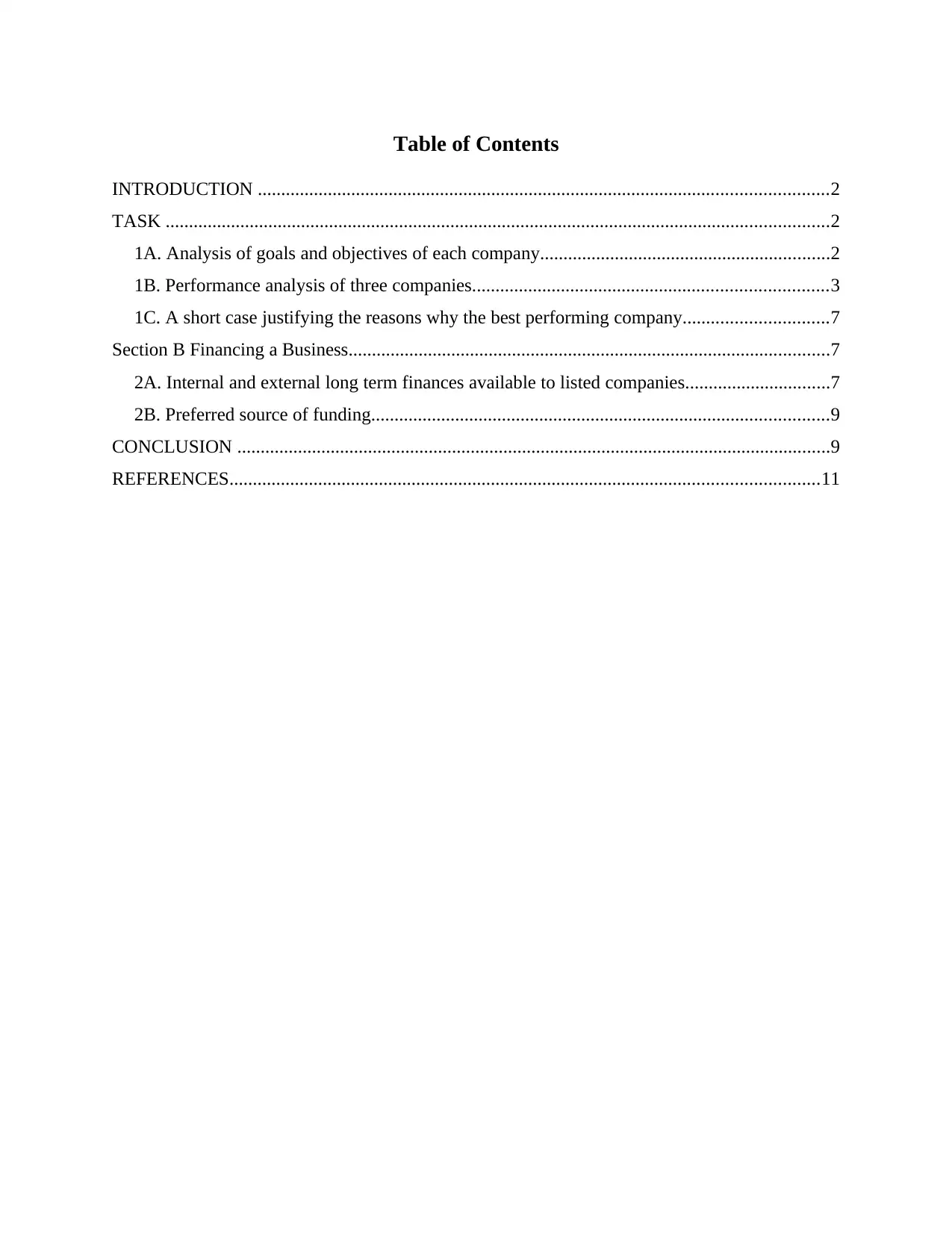
Table of Contents
INTRODUCTION ..........................................................................................................................2
TASK ..............................................................................................................................................2
1A. Analysis of goals and objectives of each company..............................................................2
1B. Performance analysis of three companies............................................................................3
1C. A short case justifying the reasons why the best performing company...............................7
Section B Financing a Business.......................................................................................................7
2A. Internal and external long term finances available to listed companies...............................7
2B. Preferred source of funding..................................................................................................9
CONCLUSION ...............................................................................................................................9
REFERENCES..............................................................................................................................11
INTRODUCTION ..........................................................................................................................2
TASK ..............................................................................................................................................2
1A. Analysis of goals and objectives of each company..............................................................2
1B. Performance analysis of three companies............................................................................3
1C. A short case justifying the reasons why the best performing company...............................7
Section B Financing a Business.......................................................................................................7
2A. Internal and external long term finances available to listed companies...............................7
2B. Preferred source of funding..................................................................................................9
CONCLUSION ...............................................................................................................................9
REFERENCES..............................................................................................................................11
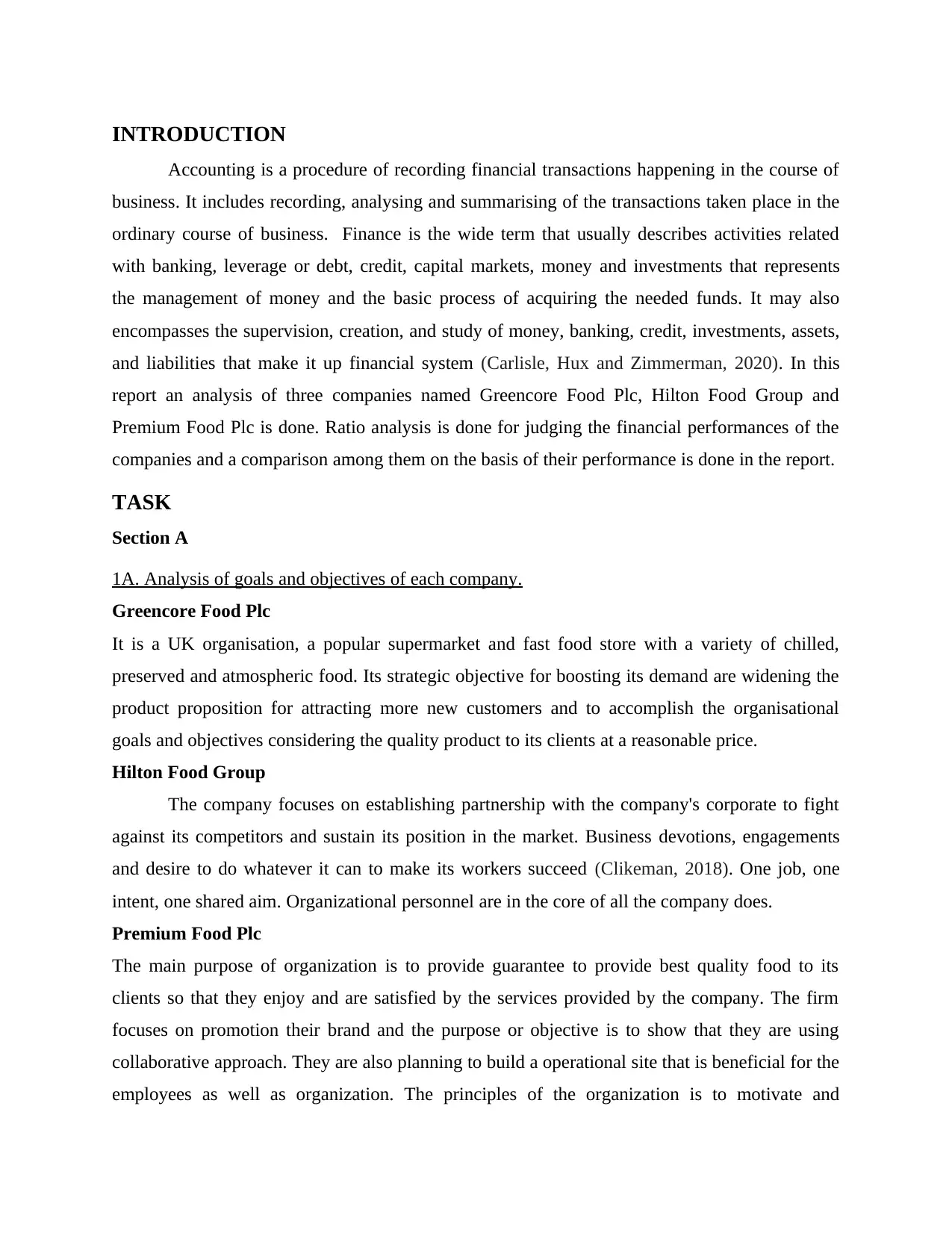
INTRODUCTION
Accounting is a procedure of recording financial transactions happening in the course of
business. It includes recording, analysing and summarising of the transactions taken place in the
ordinary course of business. Finance is the wide term that usually describes activities related
with banking, leverage or debt, credit, capital markets, money and investments that represents
the management of money and the basic process of acquiring the needed funds. It may also
encompasses the supervision, creation, and study of money, banking, credit, investments, assets,
and liabilities that make it up financial system (Carlisle, Hux and Zimmerman, 2020). In this
report an analysis of three companies named Greencore Food Plc, Hilton Food Group and
Premium Food Plc is done. Ratio analysis is done for judging the financial performances of the
companies and a comparison among them on the basis of their performance is done in the report.
TASK
Section A
1A. Analysis of goals and objectives of each company.
Greencore Food Plc
It is a UK organisation, a popular supermarket and fast food store with a variety of chilled,
preserved and atmospheric food. Its strategic objective for boosting its demand are widening the
product proposition for attracting more new customers and to accomplish the organisational
goals and objectives considering the quality product to its clients at a reasonable price.
Hilton Food Group
The company focuses on establishing partnership with the company's corporate to fight
against its competitors and sustain its position in the market. Business devotions, engagements
and desire to do whatever it can to make its workers succeed (Clikeman, 2018). One job, one
intent, one shared aim. Organizational personnel are in the core of all the company does.
Premium Food Plc
The main purpose of organization is to provide guarantee to provide best quality food to its
clients so that they enjoy and are satisfied by the services provided by the company. The firm
focuses on promotion their brand and the purpose or objective is to show that they are using
collaborative approach. They are also planning to build a operational site that is beneficial for the
employees as well as organization. The principles of the organization is to motivate and
Accounting is a procedure of recording financial transactions happening in the course of
business. It includes recording, analysing and summarising of the transactions taken place in the
ordinary course of business. Finance is the wide term that usually describes activities related
with banking, leverage or debt, credit, capital markets, money and investments that represents
the management of money and the basic process of acquiring the needed funds. It may also
encompasses the supervision, creation, and study of money, banking, credit, investments, assets,
and liabilities that make it up financial system (Carlisle, Hux and Zimmerman, 2020). In this
report an analysis of three companies named Greencore Food Plc, Hilton Food Group and
Premium Food Plc is done. Ratio analysis is done for judging the financial performances of the
companies and a comparison among them on the basis of their performance is done in the report.
TASK
Section A
1A. Analysis of goals and objectives of each company.
Greencore Food Plc
It is a UK organisation, a popular supermarket and fast food store with a variety of chilled,
preserved and atmospheric food. Its strategic objective for boosting its demand are widening the
product proposition for attracting more new customers and to accomplish the organisational
goals and objectives considering the quality product to its clients at a reasonable price.
Hilton Food Group
The company focuses on establishing partnership with the company's corporate to fight
against its competitors and sustain its position in the market. Business devotions, engagements
and desire to do whatever it can to make its workers succeed (Clikeman, 2018). One job, one
intent, one shared aim. Organizational personnel are in the core of all the company does.
Premium Food Plc
The main purpose of organization is to provide guarantee to provide best quality food to its
clients so that they enjoy and are satisfied by the services provided by the company. The firm
focuses on promotion their brand and the purpose or objective is to show that they are using
collaborative approach. They are also planning to build a operational site that is beneficial for the
employees as well as organization. The principles of the organization is to motivate and
⊘ This is a preview!⊘
Do you want full access?
Subscribe today to unlock all pages.

Trusted by 1+ million students worldwide
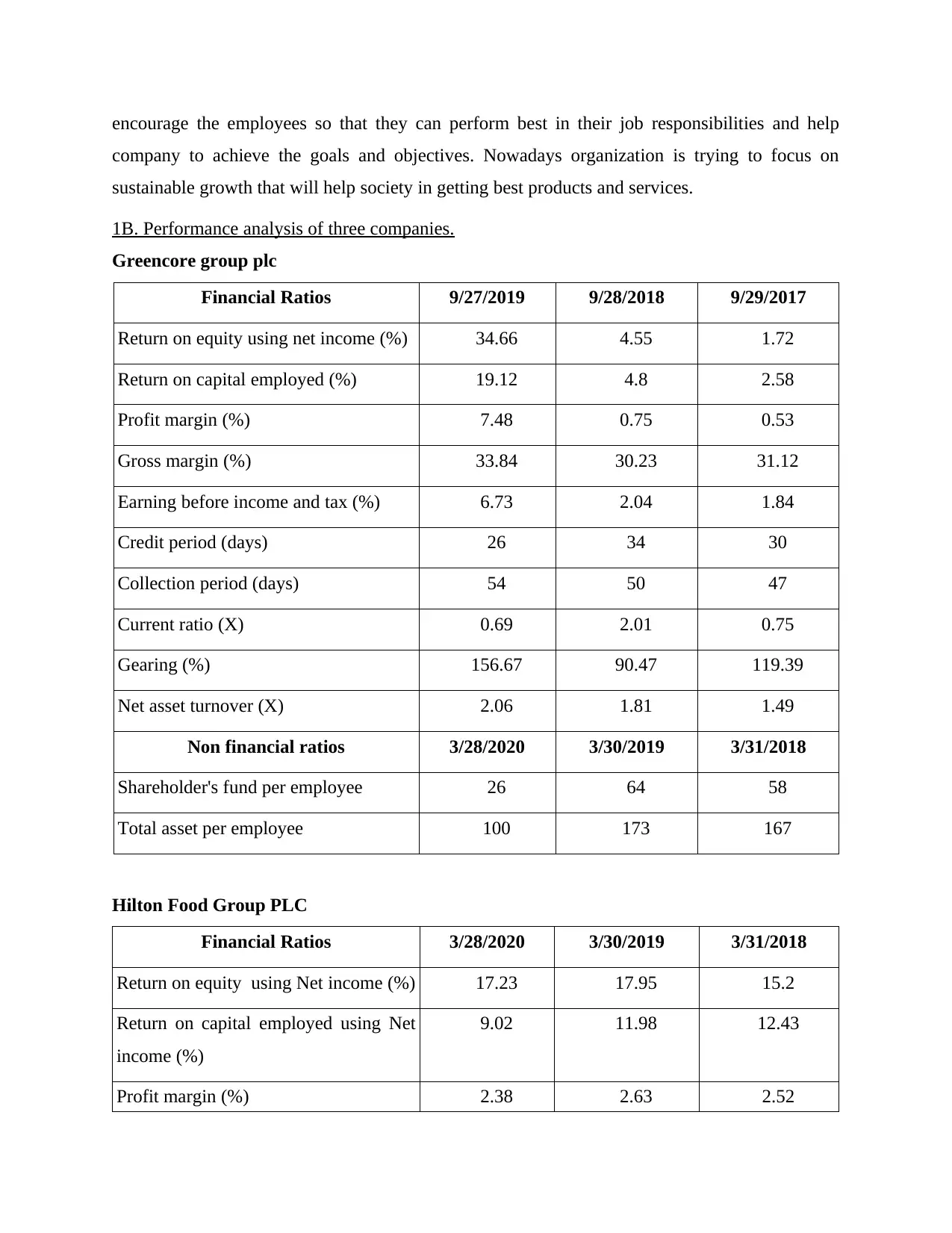
encourage the employees so that they can perform best in their job responsibilities and help
company to achieve the goals and objectives. Nowadays organization is trying to focus on
sustainable growth that will help society in getting best products and services.
1B. Performance analysis of three companies.
Greencore group plc
Financial Ratios 9/27/2019 9/28/2018 9/29/2017
Return on equity using net income (%) 34.66 4.55 1.72
Return on capital employed (%) 19.12 4.8 2.58
Profit margin (%) 7.48 0.75 0.53
Gross margin (%) 33.84 30.23 31.12
Earning before income and tax (%) 6.73 2.04 1.84
Credit period (days) 26 34 30
Collection period (days) 54 50 47
Current ratio (X) 0.69 2.01 0.75
Gearing (%) 156.67 90.47 119.39
Net asset turnover (X) 2.06 1.81 1.49
Non financial ratios 3/28/2020 3/30/2019 3/31/2018
Shareholder's fund per employee 26 64 58
Total asset per employee 100 173 167
Hilton Food Group PLC
Financial Ratios 3/28/2020 3/30/2019 3/31/2018
Return on equity using Net income (%) 17.23 17.95 15.2
Return on capital employed using Net
income (%)
9.02 11.98 12.43
Profit margin (%) 2.38 2.63 2.52
company to achieve the goals and objectives. Nowadays organization is trying to focus on
sustainable growth that will help society in getting best products and services.
1B. Performance analysis of three companies.
Greencore group plc
Financial Ratios 9/27/2019 9/28/2018 9/29/2017
Return on equity using net income (%) 34.66 4.55 1.72
Return on capital employed (%) 19.12 4.8 2.58
Profit margin (%) 7.48 0.75 0.53
Gross margin (%) 33.84 30.23 31.12
Earning before income and tax (%) 6.73 2.04 1.84
Credit period (days) 26 34 30
Collection period (days) 54 50 47
Current ratio (X) 0.69 2.01 0.75
Gearing (%) 156.67 90.47 119.39
Net asset turnover (X) 2.06 1.81 1.49
Non financial ratios 3/28/2020 3/30/2019 3/31/2018
Shareholder's fund per employee 26 64 58
Total asset per employee 100 173 167
Hilton Food Group PLC
Financial Ratios 3/28/2020 3/30/2019 3/31/2018
Return on equity using Net income (%) 17.23 17.95 15.2
Return on capital employed using Net
income (%)
9.02 11.98 12.43
Profit margin (%) 2.38 2.63 2.52
Paraphrase This Document
Need a fresh take? Get an instant paraphrase of this document with our AI Paraphraser
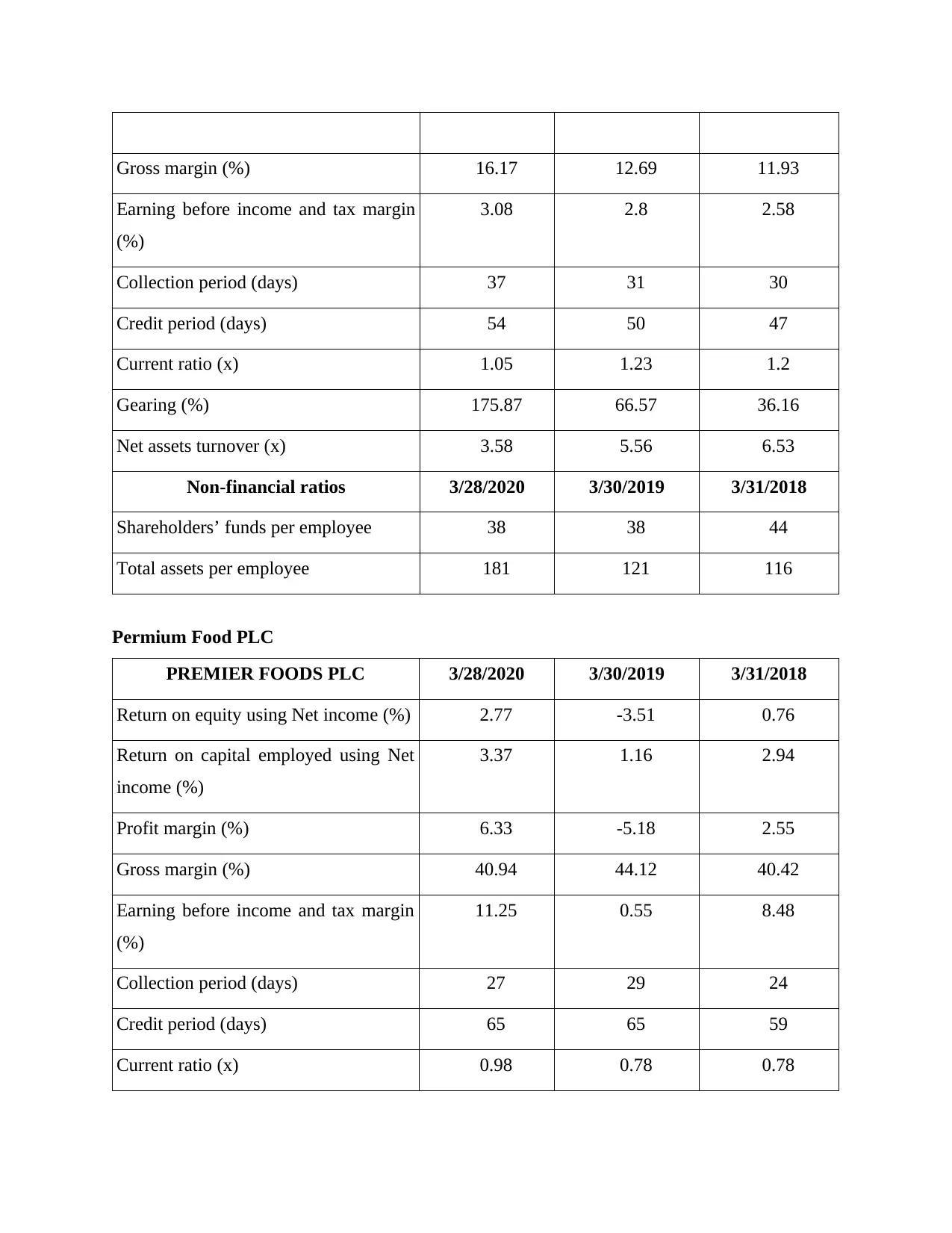
Gross margin (%) 16.17 12.69 11.93
Earning before income and tax margin
(%)
3.08 2.8 2.58
Collection period (days) 37 31 30
Credit period (days) 54 50 47
Current ratio (x) 1.05 1.23 1.2
Gearing (%) 175.87 66.57 36.16
Net assets turnover (x) 3.58 5.56 6.53
Non-financial ratios 3/28/2020 3/30/2019 3/31/2018
Shareholders’ funds per employee 38 38 44
Total assets per employee 181 121 116
Permium Food PLC
PREMIER FOODS PLC 3/28/2020 3/30/2019 3/31/2018
Return on equity using Net income (%) 2.77 -3.51 0.76
Return on capital employed using Net
income (%)
3.37 1.16 2.94
Profit margin (%) 6.33 -5.18 2.55
Gross margin (%) 40.94 44.12 40.42
Earning before income and tax margin
(%)
11.25 0.55 8.48
Collection period (days) 27 29 24
Credit period (days) 65 65 59
Current ratio (x) 0.98 0.78 0.78
Earning before income and tax margin
(%)
3.08 2.8 2.58
Collection period (days) 37 31 30
Credit period (days) 54 50 47
Current ratio (x) 1.05 1.23 1.2
Gearing (%) 175.87 66.57 36.16
Net assets turnover (x) 3.58 5.56 6.53
Non-financial ratios 3/28/2020 3/30/2019 3/31/2018
Shareholders’ funds per employee 38 38 44
Total assets per employee 181 121 116
Permium Food PLC
PREMIER FOODS PLC 3/28/2020 3/30/2019 3/31/2018
Return on equity using Net income (%) 2.77 -3.51 0.76
Return on capital employed using Net
income (%)
3.37 1.16 2.94
Profit margin (%) 6.33 -5.18 2.55
Gross margin (%) 40.94 44.12 40.42
Earning before income and tax margin
(%)
11.25 0.55 8.48
Collection period (days) 27 29 24
Credit period (days) 65 65 59
Current ratio (x) 0.98 0.78 0.78
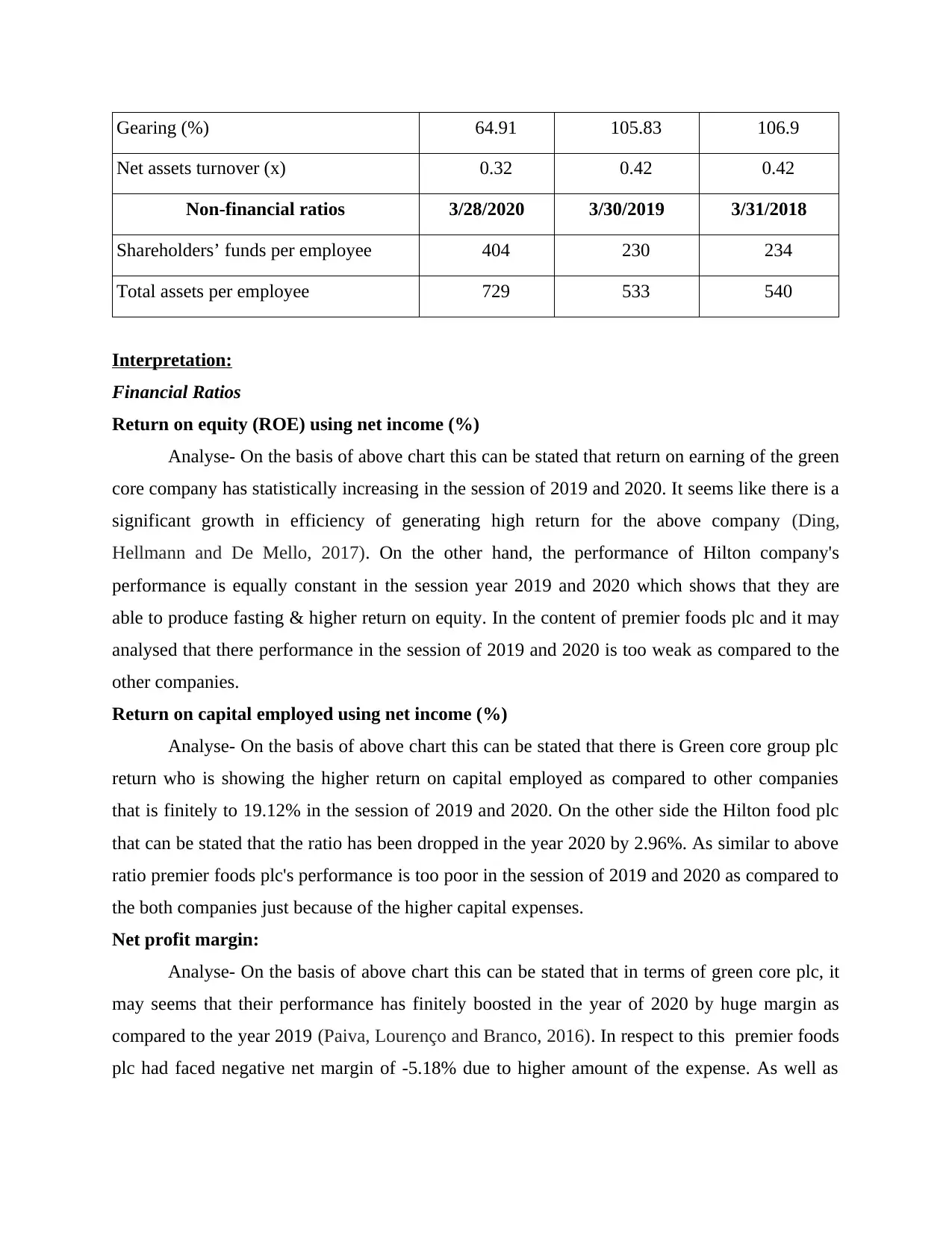
Gearing (%) 64.91 105.83 106.9
Net assets turnover (x) 0.32 0.42 0.42
Non-financial ratios 3/28/2020 3/30/2019 3/31/2018
Shareholders’ funds per employee 404 230 234
Total assets per employee 729 533 540
Interpretation:
Financial Ratios
Return on equity (ROE) using net income (%)
Analyse- On the basis of above chart this can be stated that return on earning of the green
core company has statistically increasing in the session of 2019 and 2020. It seems like there is a
significant growth in efficiency of generating high return for the above company (Ding,
Hellmann and De Mello, 2017). On the other hand, the performance of Hilton company's
performance is equally constant in the session year 2019 and 2020 which shows that they are
able to produce fasting & higher return on equity. In the content of premier foods plc and it may
analysed that there performance in the session of 2019 and 2020 is too weak as compared to the
other companies.
Return on capital employed using net income (%)
Analyse- On the basis of above chart this can be stated that there is Green core group plc
return who is showing the higher return on capital employed as compared to other companies
that is finitely to 19.12% in the session of 2019 and 2020. On the other side the Hilton food plc
that can be stated that the ratio has been dropped in the year 2020 by 2.96%. As similar to above
ratio premier foods plc's performance is too poor in the session of 2019 and 2020 as compared to
the both companies just because of the higher capital expenses.
Net profit margin:
Analyse- On the basis of above chart this can be stated that in terms of green core plc, it
may seems that their performance has finitely boosted in the year of 2020 by huge margin as
compared to the year 2019 (Paiva, Lourenço and Branco, 2016). In respect to this premier foods
plc had faced negative net margin of -5.18% due to higher amount of the expense. As well as
Net assets turnover (x) 0.32 0.42 0.42
Non-financial ratios 3/28/2020 3/30/2019 3/31/2018
Shareholders’ funds per employee 404 230 234
Total assets per employee 729 533 540
Interpretation:
Financial Ratios
Return on equity (ROE) using net income (%)
Analyse- On the basis of above chart this can be stated that return on earning of the green
core company has statistically increasing in the session of 2019 and 2020. It seems like there is a
significant growth in efficiency of generating high return for the above company (Ding,
Hellmann and De Mello, 2017). On the other hand, the performance of Hilton company's
performance is equally constant in the session year 2019 and 2020 which shows that they are
able to produce fasting & higher return on equity. In the content of premier foods plc and it may
analysed that there performance in the session of 2019 and 2020 is too weak as compared to the
other companies.
Return on capital employed using net income (%)
Analyse- On the basis of above chart this can be stated that there is Green core group plc
return who is showing the higher return on capital employed as compared to other companies
that is finitely to 19.12% in the session of 2019 and 2020. On the other side the Hilton food plc
that can be stated that the ratio has been dropped in the year 2020 by 2.96%. As similar to above
ratio premier foods plc's performance is too poor in the session of 2019 and 2020 as compared to
the both companies just because of the higher capital expenses.
Net profit margin:
Analyse- On the basis of above chart this can be stated that in terms of green core plc, it
may seems that their performance has finitely boosted in the year of 2020 by huge margin as
compared to the year 2019 (Paiva, Lourenço and Branco, 2016). In respect to this premier foods
plc had faced negative net margin of -5.18% due to higher amount of the expense. As well as
⊘ This is a preview!⊘
Do you want full access?
Subscribe today to unlock all pages.

Trusted by 1+ million students worldwide
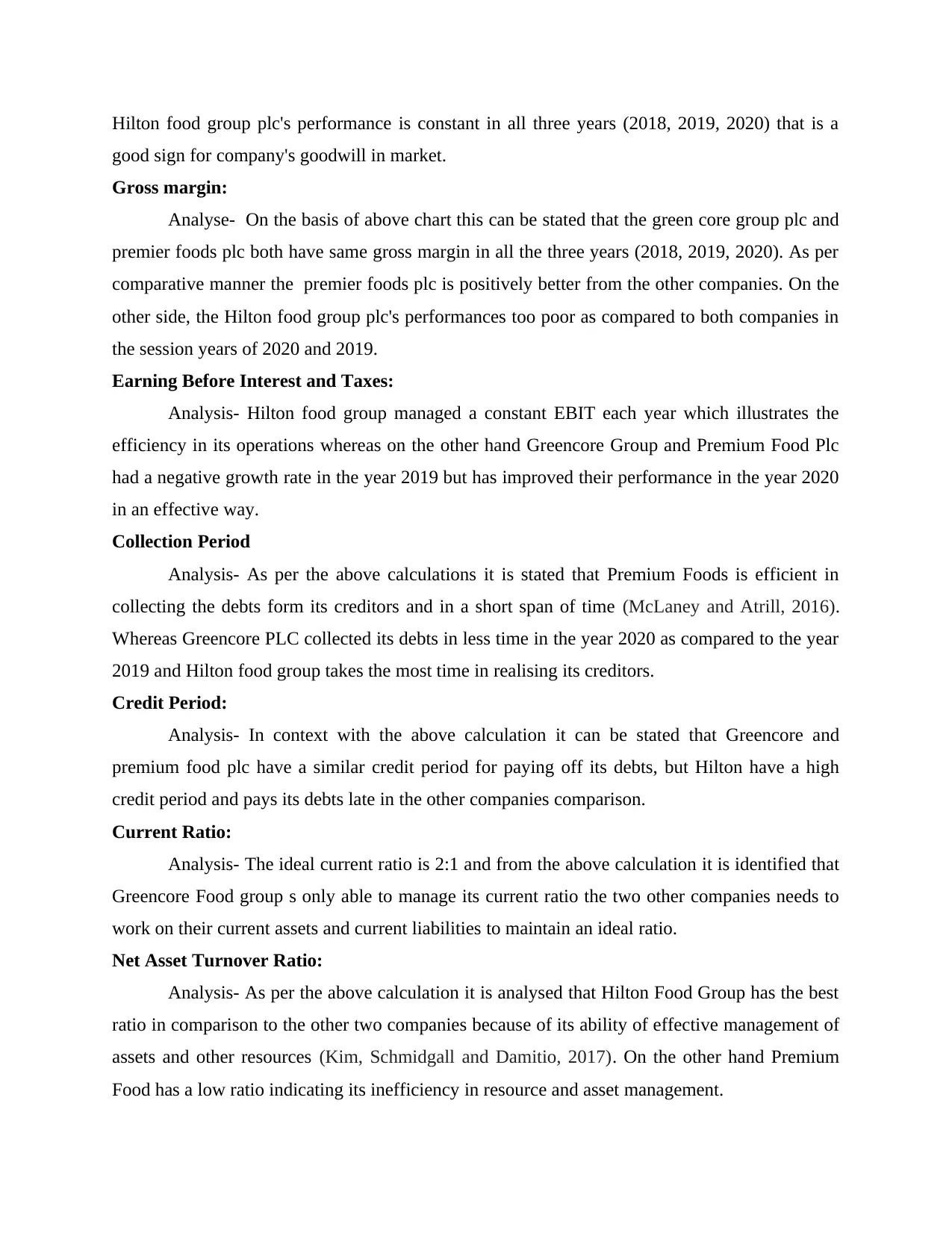
Hilton food group plc's performance is constant in all three years (2018, 2019, 2020) that is a
good sign for company's goodwill in market.
Gross margin:
Analyse- On the basis of above chart this can be stated that the green core group plc and
premier foods plc both have same gross margin in all the three years (2018, 2019, 2020). As per
comparative manner the premier foods plc is positively better from the other companies. On the
other side, the Hilton food group plc's performances too poor as compared to both companies in
the session years of 2020 and 2019.
Earning Before Interest and Taxes:
Analysis- Hilton food group managed a constant EBIT each year which illustrates the
efficiency in its operations whereas on the other hand Greencore Group and Premium Food Plc
had a negative growth rate in the year 2019 but has improved their performance in the year 2020
in an effective way.
Collection Period
Analysis- As per the above calculations it is stated that Premium Foods is efficient in
collecting the debts form its creditors and in a short span of time (McLaney and Atrill, 2016).
Whereas Greencore PLC collected its debts in less time in the year 2020 as compared to the year
2019 and Hilton food group takes the most time in realising its creditors.
Credit Period:
Analysis- In context with the above calculation it can be stated that Greencore and
premium food plc have a similar credit period for paying off its debts, but Hilton have a high
credit period and pays its debts late in the other companies comparison.
Current Ratio:
Analysis- The ideal current ratio is 2:1 and from the above calculation it is identified that
Greencore Food group s only able to manage its current ratio the two other companies needs to
work on their current assets and current liabilities to maintain an ideal ratio.
Net Asset Turnover Ratio:
Analysis- As per the above calculation it is analysed that Hilton Food Group has the best
ratio in comparison to the other two companies because of its ability of effective management of
assets and other resources (Kim, Schmidgall and Damitio, 2017). On the other hand Premium
Food has a low ratio indicating its inefficiency in resource and asset management.
good sign for company's goodwill in market.
Gross margin:
Analyse- On the basis of above chart this can be stated that the green core group plc and
premier foods plc both have same gross margin in all the three years (2018, 2019, 2020). As per
comparative manner the premier foods plc is positively better from the other companies. On the
other side, the Hilton food group plc's performances too poor as compared to both companies in
the session years of 2020 and 2019.
Earning Before Interest and Taxes:
Analysis- Hilton food group managed a constant EBIT each year which illustrates the
efficiency in its operations whereas on the other hand Greencore Group and Premium Food Plc
had a negative growth rate in the year 2019 but has improved their performance in the year 2020
in an effective way.
Collection Period
Analysis- As per the above calculations it is stated that Premium Foods is efficient in
collecting the debts form its creditors and in a short span of time (McLaney and Atrill, 2016).
Whereas Greencore PLC collected its debts in less time in the year 2020 as compared to the year
2019 and Hilton food group takes the most time in realising its creditors.
Credit Period:
Analysis- In context with the above calculation it can be stated that Greencore and
premium food plc have a similar credit period for paying off its debts, but Hilton have a high
credit period and pays its debts late in the other companies comparison.
Current Ratio:
Analysis- The ideal current ratio is 2:1 and from the above calculation it is identified that
Greencore Food group s only able to manage its current ratio the two other companies needs to
work on their current assets and current liabilities to maintain an ideal ratio.
Net Asset Turnover Ratio:
Analysis- As per the above calculation it is analysed that Hilton Food Group has the best
ratio in comparison to the other two companies because of its ability of effective management of
assets and other resources (Kim, Schmidgall and Damitio, 2017). On the other hand Premium
Food has a low ratio indicating its inefficiency in resource and asset management.
Paraphrase This Document
Need a fresh take? Get an instant paraphrase of this document with our AI Paraphraser
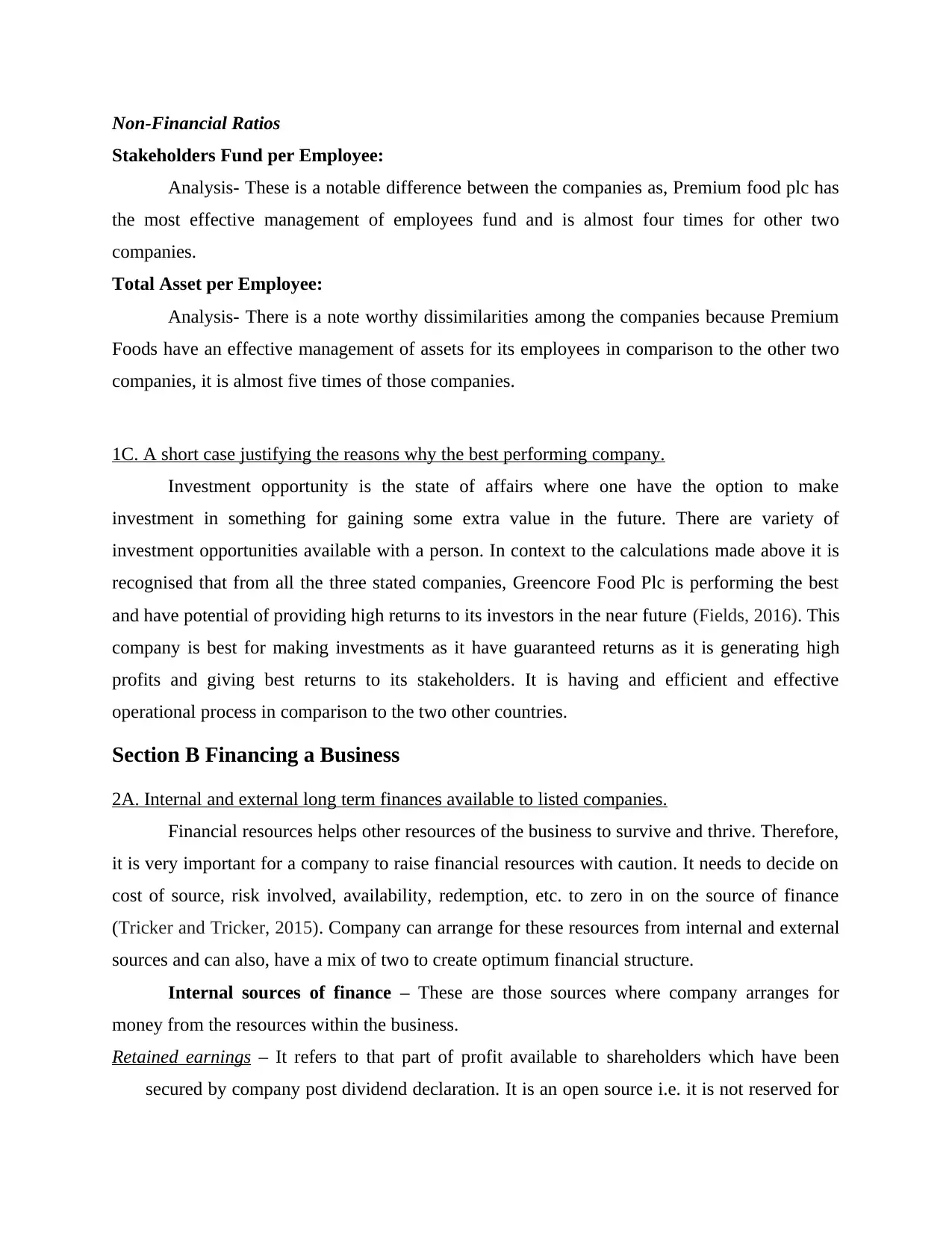
Non-Financial Ratios
Stakeholders Fund per Employee:
Analysis- These is a notable difference between the companies as, Premium food plc has
the most effective management of employees fund and is almost four times for other two
companies.
Total Asset per Employee:
Analysis- There is a note worthy dissimilarities among the companies because Premium
Foods have an effective management of assets for its employees in comparison to the other two
companies, it is almost five times of those companies.
1C. A short case justifying the reasons why the best performing company.
Investment opportunity is the state of affairs where one have the option to make
investment in something for gaining some extra value in the future. There are variety of
investment opportunities available with a person. In context to the calculations made above it is
recognised that from all the three stated companies, Greencore Food Plc is performing the best
and have potential of providing high returns to its investors in the near future (Fields, 2016). This
company is best for making investments as it have guaranteed returns as it is generating high
profits and giving best returns to its stakeholders. It is having and efficient and effective
operational process in comparison to the two other countries.
Section B Financing a Business
2A. Internal and external long term finances available to listed companies.
Financial resources helps other resources of the business to survive and thrive. Therefore,
it is very important for a company to raise financial resources with caution. It needs to decide on
cost of source, risk involved, availability, redemption, etc. to zero in on the source of finance
(Tricker and Tricker, 2015). Company can arrange for these resources from internal and external
sources and can also, have a mix of two to create optimum financial structure.
Internal sources of finance – These are those sources where company arranges for
money from the resources within the business.
Retained earnings – It refers to that part of profit available to shareholders which have been
secured by company post dividend declaration. It is an open source i.e. it is not reserved for
Stakeholders Fund per Employee:
Analysis- These is a notable difference between the companies as, Premium food plc has
the most effective management of employees fund and is almost four times for other two
companies.
Total Asset per Employee:
Analysis- There is a note worthy dissimilarities among the companies because Premium
Foods have an effective management of assets for its employees in comparison to the other two
companies, it is almost five times of those companies.
1C. A short case justifying the reasons why the best performing company.
Investment opportunity is the state of affairs where one have the option to make
investment in something for gaining some extra value in the future. There are variety of
investment opportunities available with a person. In context to the calculations made above it is
recognised that from all the three stated companies, Greencore Food Plc is performing the best
and have potential of providing high returns to its investors in the near future (Fields, 2016). This
company is best for making investments as it have guaranteed returns as it is generating high
profits and giving best returns to its stakeholders. It is having and efficient and effective
operational process in comparison to the two other countries.
Section B Financing a Business
2A. Internal and external long term finances available to listed companies.
Financial resources helps other resources of the business to survive and thrive. Therefore,
it is very important for a company to raise financial resources with caution. It needs to decide on
cost of source, risk involved, availability, redemption, etc. to zero in on the source of finance
(Tricker and Tricker, 2015). Company can arrange for these resources from internal and external
sources and can also, have a mix of two to create optimum financial structure.
Internal sources of finance – These are those sources where company arranges for
money from the resources within the business.
Retained earnings – It refers to that part of profit available to shareholders which have been
secured by company post dividend declaration. It is an open source i.e. it is not reserved for
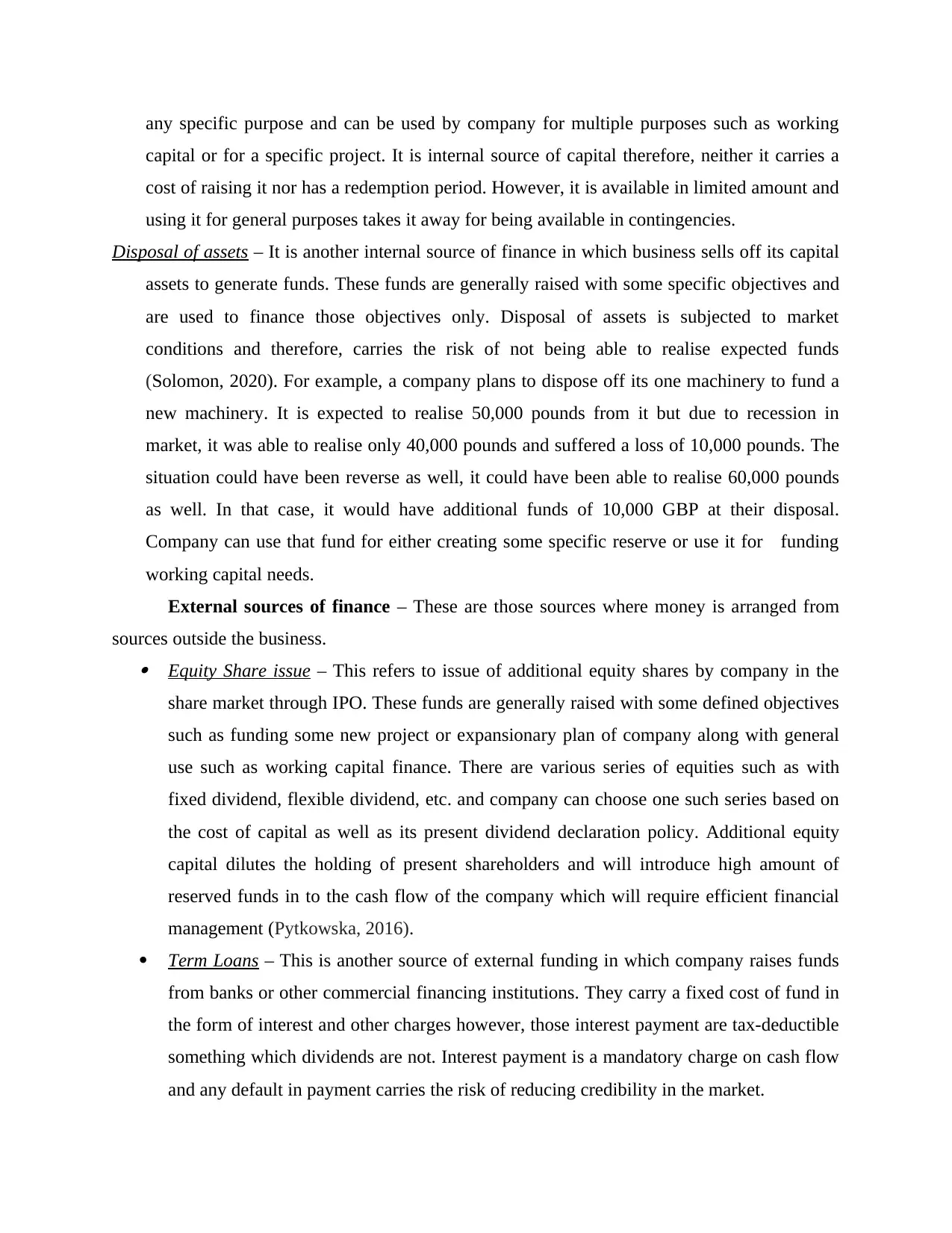
any specific purpose and can be used by company for multiple purposes such as working
capital or for a specific project. It is internal source of capital therefore, neither it carries a
cost of raising it nor has a redemption period. However, it is available in limited amount and
using it for general purposes takes it away for being available in contingencies.
Disposal of assets – It is another internal source of finance in which business sells off its capital
assets to generate funds. These funds are generally raised with some specific objectives and
are used to finance those objectives only. Disposal of assets is subjected to market
conditions and therefore, carries the risk of not being able to realise expected funds
(Solomon, 2020). For example, a company plans to dispose off its one machinery to fund a
new machinery. It is expected to realise 50,000 pounds from it but due to recession in
market, it was able to realise only 40,000 pounds and suffered a loss of 10,000 pounds. The
situation could have been reverse as well, it could have been able to realise 60,000 pounds
as well. In that case, it would have additional funds of 10,000 GBP at their disposal.
Company can use that fund for either creating some specific reserve or use it for funding
working capital needs.
External sources of finance – These are those sources where money is arranged from
sources outside the business. Equity Share issue – This refers to issue of additional equity shares by company in the
share market through IPO. These funds are generally raised with some defined objectives
such as funding some new project or expansionary plan of company along with general
use such as working capital finance. There are various series of equities such as with
fixed dividend, flexible dividend, etc. and company can choose one such series based on
the cost of capital as well as its present dividend declaration policy. Additional equity
capital dilutes the holding of present shareholders and will introduce high amount of
reserved funds in to the cash flow of the company which will require efficient financial
management (Pytkowska, 2016).
Term Loans – This is another source of external funding in which company raises funds
from banks or other commercial financing institutions. They carry a fixed cost of fund in
the form of interest and other charges however, those interest payment are tax-deductible
something which dividends are not. Interest payment is a mandatory charge on cash flow
and any default in payment carries the risk of reducing credibility in the market.
capital or for a specific project. It is internal source of capital therefore, neither it carries a
cost of raising it nor has a redemption period. However, it is available in limited amount and
using it for general purposes takes it away for being available in contingencies.
Disposal of assets – It is another internal source of finance in which business sells off its capital
assets to generate funds. These funds are generally raised with some specific objectives and
are used to finance those objectives only. Disposal of assets is subjected to market
conditions and therefore, carries the risk of not being able to realise expected funds
(Solomon, 2020). For example, a company plans to dispose off its one machinery to fund a
new machinery. It is expected to realise 50,000 pounds from it but due to recession in
market, it was able to realise only 40,000 pounds and suffered a loss of 10,000 pounds. The
situation could have been reverse as well, it could have been able to realise 60,000 pounds
as well. In that case, it would have additional funds of 10,000 GBP at their disposal.
Company can use that fund for either creating some specific reserve or use it for funding
working capital needs.
External sources of finance – These are those sources where money is arranged from
sources outside the business. Equity Share issue – This refers to issue of additional equity shares by company in the
share market through IPO. These funds are generally raised with some defined objectives
such as funding some new project or expansionary plan of company along with general
use such as working capital finance. There are various series of equities such as with
fixed dividend, flexible dividend, etc. and company can choose one such series based on
the cost of capital as well as its present dividend declaration policy. Additional equity
capital dilutes the holding of present shareholders and will introduce high amount of
reserved funds in to the cash flow of the company which will require efficient financial
management (Pytkowska, 2016).
Term Loans – This is another source of external funding in which company raises funds
from banks or other commercial financing institutions. They carry a fixed cost of fund in
the form of interest and other charges however, those interest payment are tax-deductible
something which dividends are not. Interest payment is a mandatory charge on cash flow
and any default in payment carries the risk of reducing credibility in the market.
⊘ This is a preview!⊘
Do you want full access?
Subscribe today to unlock all pages.

Trusted by 1+ million students worldwide
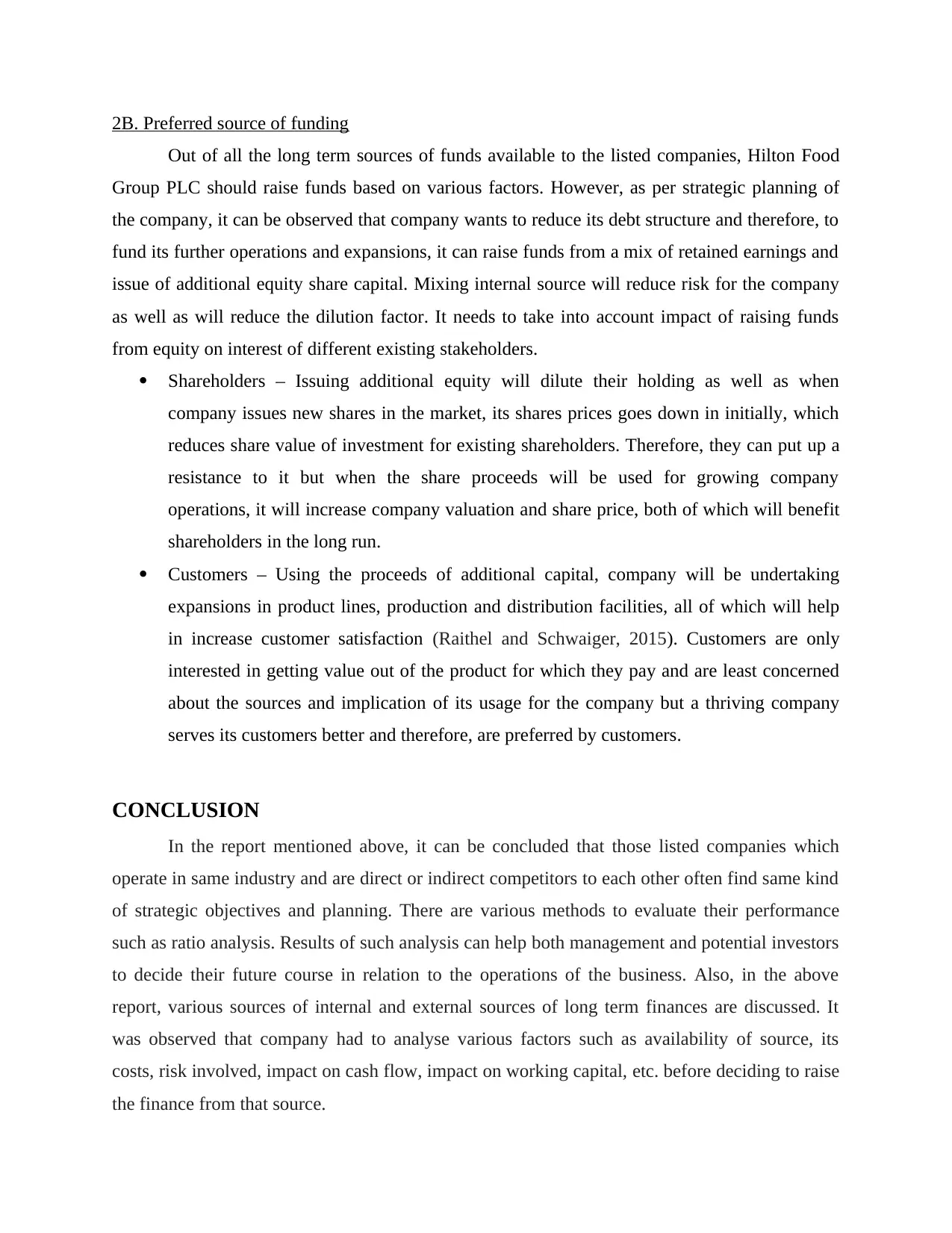
2B. Preferred source of funding
Out of all the long term sources of funds available to the listed companies, Hilton Food
Group PLC should raise funds based on various factors. However, as per strategic planning of
the company, it can be observed that company wants to reduce its debt structure and therefore, to
fund its further operations and expansions, it can raise funds from a mix of retained earnings and
issue of additional equity share capital. Mixing internal source will reduce risk for the company
as well as will reduce the dilution factor. It needs to take into account impact of raising funds
from equity on interest of different existing stakeholders.
Shareholders – Issuing additional equity will dilute their holding as well as when
company issues new shares in the market, its shares prices goes down in initially, which
reduces share value of investment for existing shareholders. Therefore, they can put up a
resistance to it but when the share proceeds will be used for growing company
operations, it will increase company valuation and share price, both of which will benefit
shareholders in the long run.
Customers – Using the proceeds of additional capital, company will be undertaking
expansions in product lines, production and distribution facilities, all of which will help
in increase customer satisfaction (Raithel and Schwaiger, 2015). Customers are only
interested in getting value out of the product for which they pay and are least concerned
about the sources and implication of its usage for the company but a thriving company
serves its customers better and therefore, are preferred by customers.
CONCLUSION
In the report mentioned above, it can be concluded that those listed companies which
operate in same industry and are direct or indirect competitors to each other often find same kind
of strategic objectives and planning. There are various methods to evaluate their performance
such as ratio analysis. Results of such analysis can help both management and potential investors
to decide their future course in relation to the operations of the business. Also, in the above
report, various sources of internal and external sources of long term finances are discussed. It
was observed that company had to analyse various factors such as availability of source, its
costs, risk involved, impact on cash flow, impact on working capital, etc. before deciding to raise
the finance from that source.
Out of all the long term sources of funds available to the listed companies, Hilton Food
Group PLC should raise funds based on various factors. However, as per strategic planning of
the company, it can be observed that company wants to reduce its debt structure and therefore, to
fund its further operations and expansions, it can raise funds from a mix of retained earnings and
issue of additional equity share capital. Mixing internal source will reduce risk for the company
as well as will reduce the dilution factor. It needs to take into account impact of raising funds
from equity on interest of different existing stakeholders.
Shareholders – Issuing additional equity will dilute their holding as well as when
company issues new shares in the market, its shares prices goes down in initially, which
reduces share value of investment for existing shareholders. Therefore, they can put up a
resistance to it but when the share proceeds will be used for growing company
operations, it will increase company valuation and share price, both of which will benefit
shareholders in the long run.
Customers – Using the proceeds of additional capital, company will be undertaking
expansions in product lines, production and distribution facilities, all of which will help
in increase customer satisfaction (Raithel and Schwaiger, 2015). Customers are only
interested in getting value out of the product for which they pay and are least concerned
about the sources and implication of its usage for the company but a thriving company
serves its customers better and therefore, are preferred by customers.
CONCLUSION
In the report mentioned above, it can be concluded that those listed companies which
operate in same industry and are direct or indirect competitors to each other often find same kind
of strategic objectives and planning. There are various methods to evaluate their performance
such as ratio analysis. Results of such analysis can help both management and potential investors
to decide their future course in relation to the operations of the business. Also, in the above
report, various sources of internal and external sources of long term finances are discussed. It
was observed that company had to analyse various factors such as availability of source, its
costs, risk involved, impact on cash flow, impact on working capital, etc. before deciding to raise
the finance from that source.
Paraphrase This Document
Need a fresh take? Get an instant paraphrase of this document with our AI Paraphraser

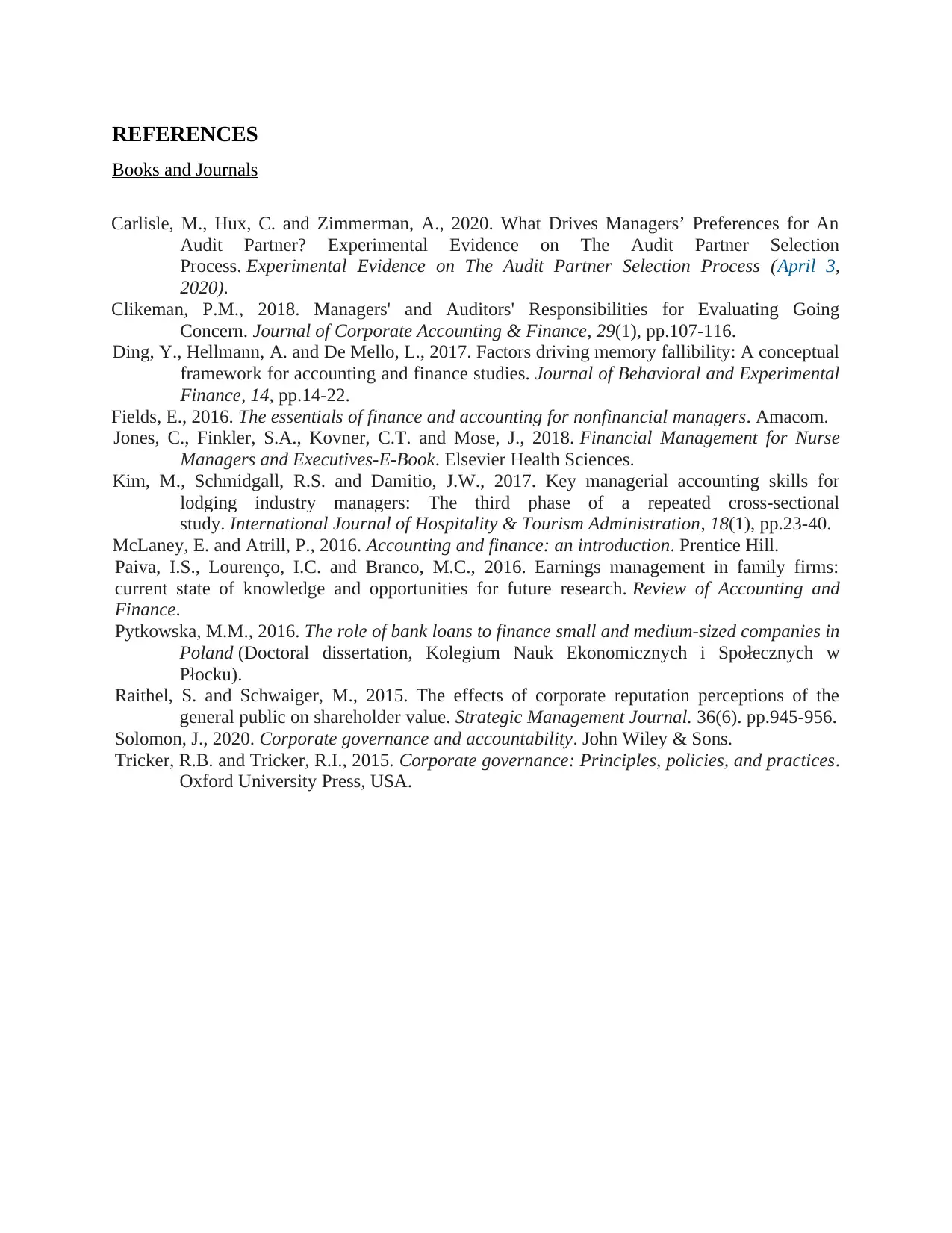
REFERENCES
Books and Journals
Carlisle, M., Hux, C. and Zimmerman, A., 2020. What Drives Managers’ Preferences for An
Audit Partner? Experimental Evidence on The Audit Partner Selection
Process. Experimental Evidence on The Audit Partner Selection Process (April 3,
2020).
Clikeman, P.M., 2018. Managers' and Auditors' Responsibilities for Evaluating Going
Concern. Journal of Corporate Accounting & Finance, 29(1), pp.107-116.
Ding, Y., Hellmann, A. and De Mello, L., 2017. Factors driving memory fallibility: A conceptual
framework for accounting and finance studies. Journal of Behavioral and Experimental
Finance, 14, pp.14-22.
Fields, E., 2016. The essentials of finance and accounting for nonfinancial managers. Amacom.
Jones, C., Finkler, S.A., Kovner, C.T. and Mose, J., 2018. Financial Management for Nurse
Managers and Executives-E-Book. Elsevier Health Sciences.
Kim, M., Schmidgall, R.S. and Damitio, J.W., 2017. Key managerial accounting skills for
lodging industry managers: The third phase of a repeated cross-sectional
study. International Journal of Hospitality & Tourism Administration, 18(1), pp.23-40.
McLaney, E. and Atrill, P., 2016. Accounting and finance: an introduction. Prentice Hill.
Paiva, I.S., Lourenço, I.C. and Branco, M.C., 2016. Earnings management in family firms:
current state of knowledge and opportunities for future research. Review of Accounting and
Finance.
Pytkowska, M.M., 2016. The role of bank loans to finance small and medium-sized companies in
Poland (Doctoral dissertation, Kolegium Nauk Ekonomicznych i Społecznych w
Płocku).
Raithel, S. and Schwaiger, M., 2015. The effects of corporate reputation perceptions of the
general public on shareholder value. Strategic Management Journal. 36(6). pp.945-956.
Solomon, J., 2020. Corporate governance and accountability. John Wiley & Sons.
Tricker, R.B. and Tricker, R.I., 2015. Corporate governance: Principles, policies, and practices.
Oxford University Press, USA.
Books and Journals
Carlisle, M., Hux, C. and Zimmerman, A., 2020. What Drives Managers’ Preferences for An
Audit Partner? Experimental Evidence on The Audit Partner Selection
Process. Experimental Evidence on The Audit Partner Selection Process (April 3,
2020).
Clikeman, P.M., 2018. Managers' and Auditors' Responsibilities for Evaluating Going
Concern. Journal of Corporate Accounting & Finance, 29(1), pp.107-116.
Ding, Y., Hellmann, A. and De Mello, L., 2017. Factors driving memory fallibility: A conceptual
framework for accounting and finance studies. Journal of Behavioral and Experimental
Finance, 14, pp.14-22.
Fields, E., 2016. The essentials of finance and accounting for nonfinancial managers. Amacom.
Jones, C., Finkler, S.A., Kovner, C.T. and Mose, J., 2018. Financial Management for Nurse
Managers and Executives-E-Book. Elsevier Health Sciences.
Kim, M., Schmidgall, R.S. and Damitio, J.W., 2017. Key managerial accounting skills for
lodging industry managers: The third phase of a repeated cross-sectional
study. International Journal of Hospitality & Tourism Administration, 18(1), pp.23-40.
McLaney, E. and Atrill, P., 2016. Accounting and finance: an introduction. Prentice Hill.
Paiva, I.S., Lourenço, I.C. and Branco, M.C., 2016. Earnings management in family firms:
current state of knowledge and opportunities for future research. Review of Accounting and
Finance.
Pytkowska, M.M., 2016. The role of bank loans to finance small and medium-sized companies in
Poland (Doctoral dissertation, Kolegium Nauk Ekonomicznych i Społecznych w
Płocku).
Raithel, S. and Schwaiger, M., 2015. The effects of corporate reputation perceptions of the
general public on shareholder value. Strategic Management Journal. 36(6). pp.945-956.
Solomon, J., 2020. Corporate governance and accountability. John Wiley & Sons.
Tricker, R.B. and Tricker, R.I., 2015. Corporate governance: Principles, policies, and practices.
Oxford University Press, USA.
⊘ This is a preview!⊘
Do you want full access?
Subscribe today to unlock all pages.

Trusted by 1+ million students worldwide
1 out of 13
Related Documents
Your All-in-One AI-Powered Toolkit for Academic Success.
+13062052269
info@desklib.com
Available 24*7 on WhatsApp / Email
![[object Object]](/_next/static/media/star-bottom.7253800d.svg)
Unlock your academic potential
Copyright © 2020–2025 A2Z Services. All Rights Reserved. Developed and managed by ZUCOL.





